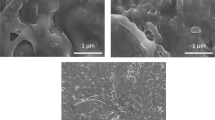Abstract
A novel cellulose and chitosan-based natural biopolymer or coagulant aids with a commercial coagulant (ferric chloride FeCl3) have been used for the removal of arsenite As(III) from synthetic tap water at 2 mg/L of initial arsenic concentration by coagulation–flocculation method. The maximum As(III) removal efficiency of 69.25% was obtained without coagulant aids at 40 mg/L concentration of FeCl3. The addition of cellulose and chitosan with FeCl3 enhanced the removal efficiency of As(III). The percentage of As(III) removal reached 84.62 and 74.87% at the concentration of 1 and 1.5 mg/L for cellulose and chitosan, respectively, with 25 mg/L of fixed FeCl3 concentration. Comparable As(III) removal efficiencies were obtained using cellulose, chitosan, and FeCl3. Moreover, As(III) removal efficiency of cellulose was significantly found greater (p < 0.01) than chitosan and comparable to that of FeCl3 (p < 0.01). In addition, the maximum percentage of As(III) removal was found at the pH range of 6–8.




Similar content being viewed by others
References
Acharya SK, Chakrabarty P, Lahiri S, Raymahashay BC, Guha S, Bhowmik A (1999) Arsenic poisoning in Ganges delta (brief communication). Nature 401:545
Acharya SK, Lahiri S, Raymahashay BC, Bhowmik A (2000) Arsenic toxicity of groundwater in parts of the Bengal basin in India and Bangladesh: the role of quaternary stratigraphy and Holocene sea-level fluctuation. Environ Geol 39:1127–1137
Ahmed MF (2001) An overview of arsenic removal technologies in Bangladesh and India. In: Proceedings of BUET-UNU international workshop on technologies for arsenic removal from drinking water, Dhaka
Ahmed F, Jalil MA, Ali MA, Hossain MD, Badruzzaman ABM (2000) An overview of arsenic removal technologies in BUET. In: Ahmed MF (ed) Bangladesh environment. Bangladesh Poribesh Andolon, Dhaka, pp 177–188
APHA (2005) Standard methods for the examination of water and wastewater, 21st edn. American Public Health Association, American Water Works Association, Water Environment Federation, Washington, DC
Bilici BM, Pala A (2009) Determination of arsenic removal efficiency by ferric ions using response surface methodology. J Hazard Mater 166:796–801
Bilici BM, Pala A, Turkman A (2010) Arsenate removal by coagulation using iron salts and organic polymers. Ekoloji 19(74):69–76
Chakraborti D, Mukherjee SC, Pati S, Sengupta MK, Rahman MM, Chowdhury UK, Lodhi D, Chanda CR, Chakraborti AK, Basul GK (2003) Arsenic groundwater contamination in Middle Ganga Plain, Bihar, India: a future danger? Environ Health Perspect 111:1194–1201
Cheng CR, Liang S, Wang HC, Beuhler MD (1994) Enhanced coagulation for arsenic removal. J Am Water Works Assoc 86(9):79–90
Dimitrovski DV, Bozinovski ZLJ, Lisichkov KT, Kuvendziev SV (2012) Arsenic removal through coagulation and flocculation from contaminated water in Macedonia. Zaštita Mater 53:57–61
Edward MA (1994) Chemistry of arsenic removal during coagulation and Fe–Mn oxidation. J Am Water Works Assoc 86:64–78
Ghosh A, Singh SK, Bose N, Chowdhary S (2007) Arsenic contaminated aquifers: a study of the Ganga levee zone in Bihar, India. In: Symposium on arsenic: the geography of a global problem. Royal Geographical Society, London, pp 29–31
Gregor J (2001) Arsenic removal during conventional aluminium-based drinking water treatment. Water Resour 35:1659–1664
Hansen HK, Nunez P, Raboy D, Schippacasse I, Gardon R (2005) Electrocoagulation in wastewater containing arsenic. Electrochim Acta 52:3464–3470
Hering JG, Elimelech M (1996) Arsenic removal by enhanced coagulation and membrane processes. Am Water Works Assoc, Denver
Hering JG, Chen PY, Wilkie JA, Elimelech M, Liang S (1996) Arsenic removal by ferric chloride. J Am Water Works Assoc 88(4):155–167
Hering JG, Chen PY, Wilkie JA, Elimelech M (1997) Arsenic removal from drinking water during coagulation. J Environ Eng 123:800–807
Joshi A, Chaudhury M (1996) Removal of arsenic from groundwater by iron-oxide-coated sand. ASCE J Environ Eng 122(8):769–771
Kartinen EO, Martin CJ (1995) An overview of arsenic removal processes. J Desalination 103:79–88
O’Connor JT (2002) Arsenic in drinking water. Part 2: human exposure and health effects. Water Eng Manag 149(3):35–37
Pande SP, Deshpande LS, Patni PM, Lutade SL (1997) Arsenic removal studies in some groundwaters of West Bengal, India. J Environ Sci Health 7:1981–1987
Renault F, Sancey B, Badot PM, Crini G (2009) Chitosan for coagulation flocculation processes-an eco-friendly approach. Eur Polym J 45:1337–1348
Saha KC (1984) Melanokeratosis rom arsenic contaminated tubewell water. Indian J Dermatol 29:37–46
Saha AK, Chakraborti C, De S (1997) Studies of genesis of arsenic in groundwater in parts of West Bengal. Indian Soc Earth Sci 24:1–5
Smedley PL, Kinniburgh DG (2002) A review of the source behavior and distribution of arsenic in natural waters. Appl Geochem 17:517–568
Song S, Lopez VA, Hernandez CDJ, Peng C, Monroy FMG, Razo SI (2006) Arsenic removal from high-arsenic water by enhanced coagulation with ferric ions and coarse calcite. Water Res 40:364–372
Wang LK, Hung YT, Shammas NK (2005) Handbook of environmental engineering, vol 3. Physicochemical treatment processes. Humana Press, New York
Wickramasinghe SR, Han B, Zimbron J, Shen Z, Karim MN (2004) Arsenic removal by coagulation and filtration: comparison of groundwaters from the United States and Bangladesh. J Desalination 169:224–231
Wilson LD (2014) An overview of coagulation–flocculation technology. Water Cond Purif Manag 56:28–34
Zouboulis A, Katsoyiannis I (2002) Removal of arsenates from contaminated water by coagulation direct filtration. Sep Sci Technol 37:2859–2873
Acknowledgments
The authors gratefully acknowledge the National Institute of Technology (NIT) Patna, India, for the financial support. We would also like to thank the Professor and Head, Department of Civil Engineering, NIT Patna, India, for providing laboratory facilities for this work.
Author information
Authors and Affiliations
Corresponding author
Ethics declarations
Conflict of interest
The authors declare that they have no competing interests.
Additional information
Editorial responsibility: M. Abbaspour.
Rights and permissions
About this article
Cite this article
Kumar, I., Quaff, A.R. Comparative study on the effectiveness of natural coagulant aids and commercial coagulant: removal of arsenic from water. Int. J. Environ. Sci. Technol. 16, 5989–5994 (2019). https://doi.org/10.1007/s13762-018-1980-8
Received:
Revised:
Accepted:
Published:
Issue Date:
DOI: https://doi.org/10.1007/s13762-018-1980-8




